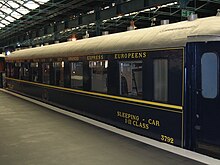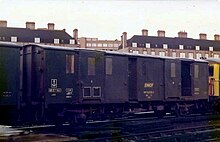Night Ferry
The Night Ferry was a sleeper train between London Victoria and Paris Gare du Nord . His cars crossed the English Channel by ferry between Dover and Dunkirk. Later it was expanded to include through cars to Brussels . It operated from 1936 to 1980, apart from a war-related break between 1939 and 1947. Before the Eurotunnel went into operation , it was the only continuous train connection between London and Paris.
vehicles


The Compagnie Internationale des Wagons-Lits (CIWL) provided the train's sleeping cars - only first class . Compared to the sleeping cars otherwise used by the company, they were smaller vehicles, adapted to the narrower British clearance profile . They had nine two-bed compartments, in contrast to normal continental sleeping cars of the CIWL, which had ten to twelve compartments with up to three beds each. The CIWL initially had 12 of these type F cars built in France . Another six type F cars were delivered in 1939, but were only used after the end of the war from 1946. Due to war losses, the CIWL procured another seven sleeping cars, which were used from 1952. In addition to four to five sleeping cars - six were rarely used - the train usually carried two French baggage cars and a dining car . After the war, in the 1950s, third and second class passenger cars were also used in the operating area of the respective railway company . Dining and seating wagons, however, were not used.
At the end of the 1950s, the line on the English side was electrified with the power rail system of the old Southern Railway and thus 750 V DC. Since then the »Night Ferry« has been hauled by an electric locomotive. Diesel locomotives have generally been used in recent years .
At the end of the 1970s, the sleeping cars originally built for the train were technically at the end of their usefulness. Some of the vehicles no longer bore the CIWL lettering, but were designated as SNCF wagons. There were no other suitable vehicles, and investing in new ones no longer seemed worthwhile. This also led to the termination of the connection.
business
The train was operated jointly by the SNCF and the Southern Railway since October 5, 1936 , after the nationalization by British Railways . Customs and fitting formalities have already taken place at Victoria Station . Between Dover ( Dover Marine Station ) and Dunkirk , the part of the train that was formed by the sleeping and baggage cars was loaded onto a ferry and divided into several segments in order to load the ferry evenly. The passengers in the seated car had to change. Because of the high differences in the water level due to the tides , the ferries used a specially built dock that - like a lock - made it possible to raise or lower the ship to the appropriate height. Each ferry had four tracks available. The crossing took about three hours. Due to the unpredictability of loading and unloading the ferries, there were often delays.
The connection was broken during the Second World War. It was resumed on December 15, 1947. From the mid-1950s, through cars to Brussels were added. A through car to Basel turned out to be a failure and was discontinued due to insufficient demand after a timetable period. The trip took about 12 hours:
| Winter timetable 1959/1960 | ||
|---|---|---|
| 21:00 | from London Victoria to | 09:10 |
| 22:42 | at Dover Marine from | 07:20 |
| 05:34 | from Dunkerque on | 01:21 |
| 09:00 | to Paris from | 22:00 |
| 08:44 | to Bruxelles from | 21:15 |
At the end of the 1970s, not only were the vehicles used technically at an end, the competition from air transport had also significantly reduced the number of passengers. The connection was therefore closed on October 31, 1980.
meaning
Before the opening of the Eurotunnel , this was the only free connection in rail passenger traffic between Great Britain and the rest of Europe . With the day train counterpart to the Night Ferry , the Golden Arrow , no train service was offered.
In art and literature, the train also became the setting:
- The Ipcress File (film) 1965
- Bryan Edgar Wallace : Murder on the Night Ferry . 1965
Preservation in a museum
Car No. 3792 from the series of sleeping cars built in 1936 now belongs to the collection of the National Railway Museum in York .
Worth knowing
In connection with the opening of the Eurotunnel in 1994, sleeping cars had already been procured for night traffic with continental Europe, which functionally would have followed the Night Ferry and were referred to as Nightstar . However, they were never used on the intended route because they would never have been profitable due to the competition from the continued growth in air traffic and the security regulations required by British lawmakers in particular, which make a connection beyond Brussels, Paris and London practically impossible. The cars were sold to VIA Rail , Canada .
literature
- George Behrend : Great Express Trains in Europe . London 1962. Chap. 2 (pp. 11-34).
- George Behrend, Gary Buchanan: Night Ferry . Jersey 1985.
- RW Kidner: The Southern Railway . South Godstone 1958.
- J. van Noord in MA Asselberghs (ed.): Daar komt de Trein . Amsterdam 1981. pp. 160-171 (in Dutch).


